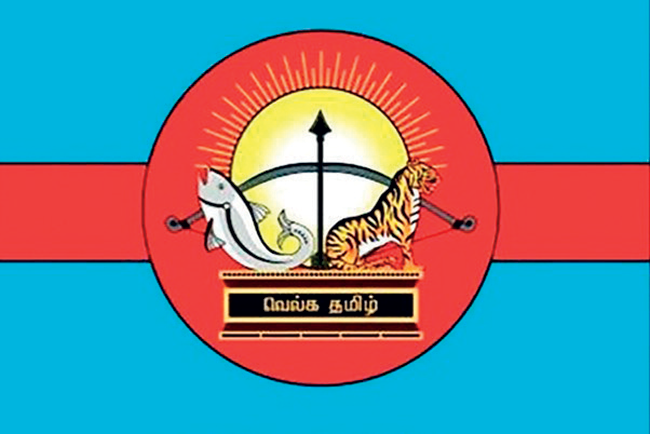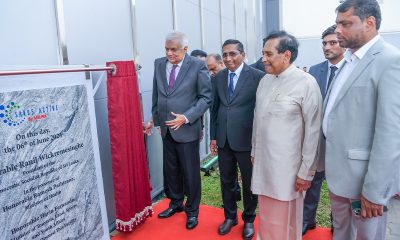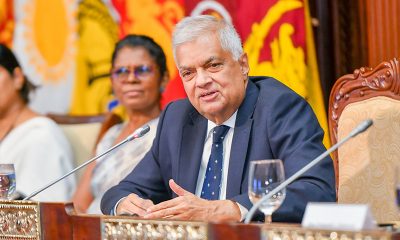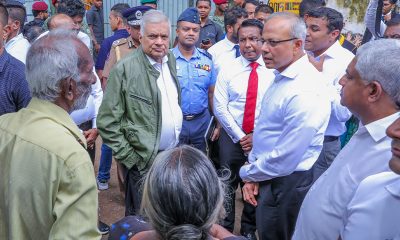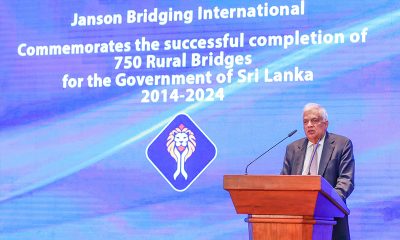Features
Our Trillion Dollar Neighbour

by Ajit Kanagasundram
President Ranil Wickremesinghe, our most economically literate leader of recent times, announced at our 75th independence celebrations, that we would be a “developed” country by 2048 – the 100th anniversary of our independence. There were no plans announced just a plain statement that this will happen and that an obscure government department would draw up the plans – no analysis or retrospection on why we had failed for 75 years and what we must change. Our politicians have always made unrealistic promises for the future like Mrs Bandaranaike’s promise to bring rice from the moon but we have a right to expect something better from an economically educated President.
One generation ago it was President J R Jayewardene’s promise to develop the country by emulating Singapore. Rather than trying to emulate Singapore, which is now beyond our league, we should look closer to hand at Tamil Nadu, which was recently forecast by Forbes to become a Trillion dollar economy within three years. This was in the context of India becoming a five trillion dollar economy within the same period – the third largest economy in the world.
Tamil Nadu, formerly Madras state, had none of the advantages we had at independence in 1948. The British did not lavish attention and build infrastructure and institutions there as they did in Ceylon, the model colony. They do not have our strategic location that attracts foreign patrons with deep pockets like China. At independence it was a backwater and lost 60% of its land and 80% of its water resources to Andra Pradesh and Karnataka when they were carved out of the Madras state. It has none of our physical attraction – hot, dry and dusty. It had only one asset – its people.
Over the past 30 years it has become the centre of the automotive manufacturing industry in India with Korean and Japanese companies leading the way. It is the centre for electrical components manufacture and recently Apple ( the world’s largest company by market capitalization) announced that it would make its new model iPhone in Tamilnadu. This is the first time that Apple has manufactured any of its products outside China and speaks volumes about the quality of the technical manpower in Tamilnadu and the available infrastructure and supply chains.
It is with Bangalore a major hub for India’s booming software industry (the word’s largest software firm Tata Consultancy Services is headquartered there and IBM, Accenture, HP and the Computer Science Corporation all have major investments). It has 34 science and engineering colleges, the graduates of which are snapped up as soon as they finish – and the jewel in its crown is the prestigious Indian Institute of Technology in Chennai. It has eight medical colleges (all but one private) whose graduates easily find jobs in India or abroad, where unlike ours, their medical degrees are recognized.
So how did they achieve this? Certainly not because their leaders have been visionary or corruption free as in Singapore – it is difficult to imagine a more venal and self serving pair of leaders than Jayalalitha or Karunanidhi, who between them have ruled the state for a majority of time during the last 40 years. Fortunately the Present Chief Minister Stalin is both honest and competent. Tamil Nadu progressed, despite having this corrupt and self-serving duo at the helm because, being mere state level politicians, they lacked the power to undermine national institutions like the Civil Service and judiciary, or corporations like the Indian Railways or the elite IT engineering schools or to change the constitution 22 times like ours have done.
While they were corrupt in their personal dealings, the inherently sound fundamentals established at time of India’s independence enabled the states like Gujarat or Tamil Nadu or Punjab, who had the right human resources, to progress such that they considered today to be a model for the rest of the country, despite their lack of resources like water.
Our politicians could do whatever they wanted if they had a parliamentary majority and they proceeded to use this absolute power to undermine all our institutions, because they were both self-serving and ignorant and stupid. Political power in India has always been with the Hindi speaking heartlands in Uttar Pradesh and Bihar and the centre has lavished state investments there.
Tamilnadu has always been a stepchild. Tamilnadu has achieved this because the people are intelligent, humble and hardworking, they do not believe the world owes them a living or depend on handouts. They do not go on strike, there has never been a communal riot, they have embraced science, technology and English. All qualities that make them an ideal workforce and Indian industrialists and foreigners have beaten a path to their door. Per capita income is among the highest of Indian States (almost equivalent to Sri Lanka), unemployment is negligible, in fact there is a labour shortage now filled by immigrants from other states).
Their tertiary institutions turn out graduates who can compete anywhere in the world – people like Sundar Pichay the CEO of Google soon tipped to be the largest high-tech company in the world. Or Indra Nooyi, the CEO of Pepsi/KFC, and featured regularly in the list of the 50 most influential business leaders in America. It has world class teaching hospitals and a thriving medical tourism business, with patients flying in from all parts of the world for kidney transplants and bypass surgery.
The universities continue to churn out superb mathematicians, in the footsteps of Ramanujan one of the all time great mathematicians and are to be found in the faculties of all the major Universities. Most of the Indian Nobel prize winners are from Tamil Nadu, and a recent Nobel prize winner in Biochemistry, Sir Venkataramn Ramakrishnan, now a fellow of Trinity in Cambridge and President of the Royal Society, stated that the reason he had to go abroad for his education was that he could not get through the competitive exam for IT Chennai!
Tamil Nadu has also had a balanced progress – not only in industry and services but in agriculture it is one of the largest producers of food grains and has a thriving dairy farming sector with surplus milk to export to other states. In dairy farming they patiently created higher yielding cows by cross breeding Holsteins and Jersey cows with local breeds – we on the other hand tried to short circuit this process and failed by importing pregnant Holsteins wholly unsuitable for our climate (95% of the cows were heat stressed and died within three months)– the only persons who benefited were the politicians who earned substantial commissions. Its horticultural industry is highly sophisticated with modern techniques of genetics used to create new and more productive breed. Meanwhile we, with better land and water resources, are reduced to importing cheap apples and oranges!
With higher income they have been able to build infrastructure – a nuclear power plant at Kalapokam, the world’s largest solar power plant (684 MW) built in eight months, water desalination plants etc. They have been able to do what we have never achieved in 70 years with one of the highest per capita levels of aid in the world – provide decent jobs for their youth in the land of their birth. They do not have to depend on the remittances from their womenfolk exploited as cheap labour abroad. And what jobs!
I can tell you from personal experience setting up the Citibank offshore technology centre in Chennai that the starting salary for regional engineering college graduate as a programmer/analyst is Indian Rupees 4 lakhs a year – equivalent to Sri Lanka rupees 75,000 per month (we should keep in mind that the cost of living, especially food, is 50% lower in Tamilnadu). Half are females and we could not get sufficient recruits for our positions because of competition from the likes of IBM. We could not even aspire to the graduates of elite institutes like the IIT whose graduates snapped up by US investment banks and consultancy firms for megabucks.
Chennai is becoming a centre for the arts – the South Indian film industry is located there and it is the centre for all Indian film music (even for Bollywood) as A R Rahman, the doyen of Indian musicians is based there and has his state of the art recording studio and school to train young musicians. There is a thriving performance culture in Bharathanatyam and traditional Carnatic music. It is a magnet for religious tourism with its ancient temples venerated by Hindus the world over.
The developments in Tamilnadu have been so remarkable that the Economist magazine devoted a recent article to it. We too can profit from their experience if we can only get over our arrogance and innate sense of superiority over the humble South Indian Tamil. We have much to learn from him.
(ajitkanagasundram@gmail.com)
Features
The heart-friendly health minister

by Dr Gotabhya Ranasinghe
Senior Consultant Cardiologist
National Hospital Sri Lanka
When we sought a meeting with Hon Dr. Ramesh Pathirana, Minister of Health, he graciously cleared his busy schedule to accommodate us. Renowned for his attentive listening and deep understanding, Minister Pathirana is dedicated to advancing the health sector. His openness and transparency exemplify the qualities of an exemplary politician and minister.
Dr. Palitha Mahipala, the current Health Secretary, demonstrates both commendable enthusiasm and unwavering support. This combination of attributes makes him a highly compatible colleague for the esteemed Minister of Health.
Our discussion centered on a project that has been in the works for the past 30 years, one that no other minister had managed to advance.
Minister Pathirana, however, recognized the project’s significance and its potential to revolutionize care for heart patients.
The project involves the construction of a state-of-the-art facility at the premises of the National Hospital Colombo. The project’s location within the premises of the National Hospital underscores its importance and relevance to the healthcare infrastructure of the nation.
This facility will include a cardiology building and a tertiary care center, equipped with the latest technology to handle and treat all types of heart-related conditions and surgeries.
Securing funding was a major milestone for this initiative. Minister Pathirana successfully obtained approval for a $40 billion loan from the Asian Development Bank. With the funding in place, the foundation stone is scheduled to be laid in September this year, and construction will begin in January 2025.
This project guarantees a consistent and uninterrupted supply of stents and related medications for heart patients. As a result, patients will have timely access to essential medical supplies during their treatment and recovery. By securing these critical resources, the project aims to enhance patient outcomes, minimize treatment delays, and maintain the highest standards of cardiac care.
Upon its fruition, this monumental building will serve as a beacon of hope and healing, symbolizing the unwavering dedication to improving patient outcomes and fostering a healthier society.We anticipate a future marked by significant progress and positive outcomes in Sri Lanka’s cardiovascular treatment landscape within the foreseeable timeframe.
Features
A LOVING TRIBUTE TO JESUIT FR. ALOYSIUS PIERIS ON HIS 90th BIRTHDAY

by Fr. Emmanuel Fernando, OMI
Jesuit Fr. Aloysius Pieris (affectionately called Fr. Aloy) celebrated his 90th birthday on April 9, 2024 and I, as the editor of our Oblate Journal, THE MISSIONARY OBLATE had gone to press by that time. Immediately I decided to publish an article, appreciating the untiring selfless services he continues to offer for inter-Faith dialogue, the renewal of the Catholic Church, his concern for the poor and the suffering Sri Lankan masses and to me, the present writer.
It was in 1988, when I was appointed Director of the Oblate Scholastics at Ampitiya by the then Oblate Provincial Fr. Anselm Silva, that I came to know Fr. Aloy more closely. Knowing well his expertise in matters spiritual, theological, Indological and pastoral, and with the collaborative spirit of my companion-formators, our Oblate Scholastics were sent to Tulana, the Research and Encounter Centre, Kelaniya, of which he is the Founder-Director, for ‘exposure-programmes’ on matters spiritual, biblical, theological and pastoral. Some of these dimensions according to my view and that of my companion-formators, were not available at the National Seminary, Ampitiya.
Ever since that time, our Oblate formators/ accompaniers at the Oblate Scholasticate, Ampitiya , have continued to send our Oblate Scholastics to Tulana Centre for deepening their insights and convictions regarding matters needed to serve the people in today’s context. Fr. Aloy also had tried very enthusiastically with the Oblate team headed by Frs. Oswald Firth and Clement Waidyasekara to begin a Theologate, directed by the Religious Congregations in Sri Lanka, for the contextual formation/ accompaniment of their members. It should very well be a desired goal of the Leaders / Provincials of the Religious Congregations.
Besides being a formator/accompanier at the Oblate Scholasticate, I was entrusted also with the task of editing and publishing our Oblate journal, ‘The Missionary Oblate’. To maintain the quality of the journal I continue to depend on Fr. Aloy for his thought-provoking and stimulating articles on Biblical Spirituality, Biblical Theology and Ecclesiology. I am very grateful to him for his generous assistance. Of late, his writings on renewal of the Church, initiated by Pope St. John XX111 and continued by Pope Francis through the Synodal path, published in our Oblate journal, enable our readers to focus their attention also on the needed renewal in the Catholic Church in Sri Lanka. Fr. Aloy appreciated very much the Synodal path adopted by the Jesuit Pope Francis for the renewal of the Church, rooted very much on prayerful discernment. In my Religious and presbyteral life, Fr.Aloy continues to be my spiritual animator / guide and ongoing formator / acccompanier.
Fr. Aloysius Pieris, BA Hons (Lond), LPh (SHC, India), STL (PFT, Naples), PhD (SLU/VC), ThD (Tilburg), D.Ltt (KU), has been one of the eminent Asian theologians well recognized internationally and one who has lectured and held visiting chairs in many universities both in the West and in the East. Many members of Religious Congregations from Asian countries have benefited from his lectures and guidance in the East Asian Pastoral Institute (EAPI) in Manila, Philippines. He had been a Theologian consulted by the Federation of Asian Bishops’ Conferences for many years. During his professorship at the Gregorian University in Rome, he was called to be a member of a special group of advisers on other religions consulted by Pope Paul VI.
Fr. Aloy is the author of more than 30 books and well over 500 Research Papers. Some of his books and articles have been translated and published in several countries. Among those books, one can find the following: 1) The Genesis of an Asian Theology of Liberation (An Autobiographical Excursus on the Art of Theologising in Asia, 2) An Asian Theology of Liberation, 3) Providential Timeliness of Vatican 11 (a long-overdue halt to a scandalous millennium, 4) Give Vatican 11 a chance, 5) Leadership in the Church, 6) Relishing our faith in working for justice (Themes for study and discussion), 7) A Message meant mainly, not exclusively for Jesuits (Background information necessary for helping Francis renew the Church), 8) Lent in Lanka (Reflections and Resolutions, 9) Love meets wisdom (A Christian Experience of Buddhism, 10) Fire and Water 11) God’s Reign for God’s poor, 12) Our Unhiddden Agenda (How we Jesuits work, pray and form our men). He is also the Editor of two journals, Vagdevi, Journal of Religious Reflection and Dialogue, New Series.
Fr. Aloy has a BA in Pali and Sanskrit from the University of London and a Ph.D in Buddhist Philosophy from the University of Sri Lankan, Vidyodaya Campus. On Nov. 23, 2019, he was awarded the prestigious honorary Doctorate of Literature (D.Litt) by the Chancellor of the University of Kelaniya, the Most Venerable Welamitiyawe Dharmakirthi Sri Kusala Dhamma Thera.
Fr. Aloy continues to be a promoter of Gospel values and virtues. Justice as a constitutive dimension of love and social concern for the downtrodden masses are very much noted in his life and work. He had very much appreciated the commitment of the late Fr. Joseph (Joe) Fernando, the National Director of the Social and Economic Centre (SEDEC) for the poor.
In Sri Lanka, a few religious Congregations – the Good Shepherd Sisters, the Christian Brothers, the Marist Brothers and the Oblates – have invited him to animate their members especially during their Provincial Congresses, Chapters and International Conferences. The mainline Christian Churches also have sought his advice and followed his seminars. I, for one, regret very much, that the Sri Lankan authorities of the Catholic Church –today’s Hierarchy—- have not sought Fr.
Aloy’s expertise for the renewal of the Catholic Church in Sri Lanka and thus have not benefited from the immense store of wisdom and insight that he can offer to our local Church while the Sri Lankan bishops who governed the Catholic church in the immediate aftermath of the Second Vatican Council (Edmund Fernando OMI, Anthony de Saram, Leo Nanayakkara OSB, Frank Marcus Fernando, Paul Perera,) visited him and consulted him on many matters. Among the Tamil Bishops, Bishop Rayappu Joseph was keeping close contact with him and Bishop J. Deogupillai hosted him and his team visiting him after the horrible Black July massacre of Tamils.
Features
A fairy tale, success or debacle

Sri Lanka-Singapore Free Trade Agreement
By Gomi Senadhira
senadhiragomi@gmail.com
“You might tell fairy tales, but the progress of a country cannot be achieved through such narratives. A country cannot be developed by making false promises. The country moved backward because of the electoral promises made by political parties throughout time. We have witnessed that the ultimate result of this is the country becoming bankrupt. Unfortunately, many segments of the population have not come to realize this yet.” – President Ranil Wickremesinghe, 2024 Budget speech
Any Sri Lankan would agree with the above words of President Wickremesinghe on the false promises our politicians and officials make and the fairy tales they narrate which bankrupted this country. So, to understand this, let’s look at one such fairy tale with lots of false promises; Ranil Wickremesinghe’s greatest achievement in the area of international trade and investment promotion during the Yahapalana period, Sri Lanka-Singapore Free Trade Agreement (SLSFTA).
It is appropriate and timely to do it now as Finance Minister Wickremesinghe has just presented to parliament a bill on the National Policy on Economic Transformation which includes the establishment of an Office for International Trade and the Sri Lanka Institute of Economics and International Trade.
Was SLSFTA a “Cleverly negotiated Free Trade Agreement” as stated by the (former) Minister of Development Strategies and International Trade Malik Samarawickrama during the Parliamentary Debate on the SLSFTA in July 2018, or a colossal blunder covered up with lies, false promises, and fairy tales? After SLSFTA was signed there were a number of fairy tales published on this agreement by the Ministry of Development Strategies and International, Institute of Policy Studies, and others.
However, for this article, I would like to limit my comments to the speech by Minister Samarawickrama during the Parliamentary Debate, and the two most important areas in the agreement which were covered up with lies, fairy tales, and false promises, namely: revenue loss for Sri Lanka and Investment from Singapore. On the other important area, “Waste products dumping” I do not want to comment here as I have written extensively on the issue.
1. The revenue loss
During the Parliamentary Debate in July 2018, Minister Samarawickrama stated “…. let me reiterate that this FTA with Singapore has been very cleverly negotiated by us…. The liberalisation programme under this FTA has been carefully designed to have the least impact on domestic industry and revenue collection. We have included all revenue sensitive items in the negative list of items which will not be subject to removal of tariff. Therefore, 97.8% revenue from Customs duty is protected. Our tariff liberalisation will take place over a period of 12-15 years! In fact, the revenue earned through tariffs on goods imported from Singapore last year was Rs. 35 billion.
The revenue loss for over the next 15 years due to the FTA is only Rs. 733 million– which when annualised, on average, is just Rs. 51 million. That is just 0.14% per year! So anyone who claims the Singapore FTA causes revenue loss to the Government cannot do basic arithmetic! Mr. Speaker, in conclusion, I call on my fellow members of this House – don’t mislead the public with baseless criticism that is not grounded in facts. Don’t look at petty politics and use these issues for your own political survival.”
I was surprised to read the minister’s speech because an article published in January 2018 in “The Straits Times“, based on information released by the Singaporean Negotiators stated, “…. With the FTA, tariff savings for Singapore exports are estimated to hit $10 million annually“.
As the annual tariff savings (that is the revenue loss for Sri Lanka) calculated by the Singaporean Negotiators, Singaporean $ 10 million (Sri Lankan rupees 1,200 million in 2018) was way above the rupees’ 733 million revenue loss for 15 years estimated by the Sri Lankan negotiators, it was clear to any observer that one of the parties to the agreement had not done the basic arithmetic!
Six years later, according to a report published by “The Morning” newspaper, speaking at the Committee on Public Finance (COPF) on 7th May 2024, Mr Samarawickrama’s chief trade negotiator K.J. Weerasinghehad had admitted “…. that forecasted revenue loss for the Government of Sri Lanka through the Singapore FTA is Rs. 450 million in 2023 and Rs. 1.3 billion in 2024.”
If these numbers are correct, as tariff liberalisation under the SLSFTA has just started, we will pass Rs 2 billion very soon. Then, the question is how Sri Lanka’s trade negotiators made such a colossal blunder. Didn’t they do their basic arithmetic? If they didn’t know how to do basic arithmetic they should have at least done their basic readings. For example, the headline of the article published in The Straits Times in January 2018 was “Singapore, Sri Lanka sign FTA, annual savings of $10m expected”.
Anyway, as Sri Lanka’s chief negotiator reiterated at the COPF meeting that “…. since 99% of the tariffs in Singapore have zero rates of duty, Sri Lanka has agreed on 80% tariff liberalisation over a period of 15 years while expecting Singapore investments to address the imbalance in trade,” let’s turn towards investment.
Investment from Singapore
In July 2018, speaking during the Parliamentary Debate on the FTA this is what Minister Malik Samarawickrama stated on investment from Singapore, “Already, thanks to this FTA, in just the past two-and-a-half months since the agreement came into effect we have received a proposal from Singapore for investment amounting to $ 14.8 billion in an oil refinery for export of petroleum products. In addition, we have proposals for a steel manufacturing plant for exports ($ 1 billion investment), flour milling plant ($ 50 million), sugar refinery ($ 200 million). This adds up to more than $ 16.05 billion in the pipeline on these projects alone.
And all of these projects will create thousands of more jobs for our people. In principle approval has already been granted by the BOI and the investors are awaiting the release of land the environmental approvals to commence the project.
I request the Opposition and those with vested interests to change their narrow-minded thinking and join us to develop our country. We must always look at what is best for the whole community, not just the few who may oppose. We owe it to our people to courageously take decisions that will change their lives for the better.”
According to the media report I quoted earlier, speaking at the Committee on Public Finance (COPF) Chief Negotiator Weerasinghe has admitted that Sri Lanka was not happy with overall Singapore investments that have come in the past few years in return for the trade liberalisation under the Singapore-Sri Lanka Free Trade Agreement. He has added that between 2021 and 2023 the total investment from Singapore had been around $162 million!
What happened to those projects worth $16 billion negotiated, thanks to the SLSFTA, in just the two-and-a-half months after the agreement came into effect and approved by the BOI? I do not know about the steel manufacturing plant for exports ($ 1 billion investment), flour milling plant ($ 50 million) and sugar refinery ($ 200 million).
However, story of the multibillion-dollar investment in the Petroleum Refinery unfolded in a manner that would qualify it as the best fairy tale with false promises presented by our politicians and the officials, prior to 2019 elections.
Though many Sri Lankans got to know, through the media which repeatedly highlighted a plethora of issues surrounding the project and the questionable credentials of the Singaporean investor, the construction work on the Mirrijiwela Oil Refinery along with the cement factory began on the24th of March 2019 with a bang and Minister Ranil Wickremesinghe and his ministers along with the foreign and local dignitaries laid the foundation stones.
That was few months before the 2019 Presidential elections. Inaugurating the construction work Prime Minister Ranil Wickremesinghe said the projects will create thousands of job opportunities in the area and surrounding districts.
The oil refinery, which was to be built over 200 acres of land, with the capacity to refine 200,000 barrels of crude oil per day, was to generate US$7 billion of exports and create 1,500 direct and 3,000 indirect jobs. The construction of the refinery was to be completed in 44 months. Four years later, in August 2023 the Cabinet of Ministers approved the proposal presented by President Ranil Wickremesinghe to cancel the agreement with the investors of the refinery as the project has not been implemented! Can they explain to the country how much money was wasted to produce that fairy tale?
It is obvious that the President, ministers, and officials had made huge blunders and had deliberately misled the public and the parliament on the revenue loss and potential investment from SLSFTA with fairy tales and false promises.
As the president himself said, a country cannot be developed by making false promises or with fairy tales and these false promises and fairy tales had bankrupted the country. “Unfortunately, many segments of the population have not come to realize this yet”.
(The writer, a specialist and an activist on trade and development issues . )

